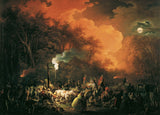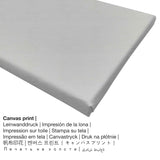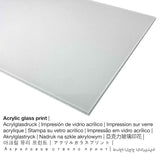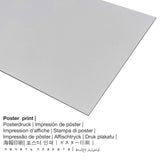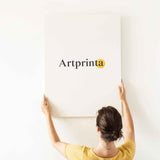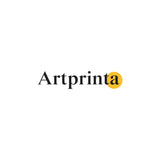Johann Josef Schindler, 1836 - Mwisho wa fataki za Stuwerschen mnamo Mei 7, 1833 - uchapishaji mzuri wa sanaa.
Kodi ni pamoja. Usafirishaji umehesabiwa katika Checkout.
Mchoro wako wa kipekee wa sanaa
Kipande hiki cha sanaa The end of the Stuwerschen fireworks on May 7, 1833 ilichorwa na kweli bwana Johann Josef Schindler. The 180 years old piece of art has the size 68 x 94 cm - vipimo vya sura: 89 x 115 x 8 cm na ilitengenezwa kwa njia ya kati mafuta kwenye turubai. Nowadays, this work of art is included in the art collection of Belvedere. With courtesy of © Belvedere, Vienna, nambari ya hesabu: 2549 (leseni ya kikoa cha umma). Mstari wa mkopo wa mchoro ni kama ifuatavyo: Uhamisho kutoka Makumbusho ya Kunsthistorisches, Vienna mnamo 1926. Zaidi ya hayo, upatanishi wa uzazi wa kidijitali ni landscape and has a ratio of 1.4 : 1, which implies that the length is 40% longer than the width. Johann Josef Schindler was a painter, whose art style can be classified as Realism. The Realist artist lived for miaka 59, born in 1777 in Pölten and deceased in the year 1836.
Maelezo ya kazi ya sanaa kutoka Belvedere (© - Belvedere - Belvedere)
Born in St. Poelten Johann Josef Schindler studied from 1790 at the Vienna Academy of Fine Arts in the class of landscape painting with Johann Christian Brand. In its Landschaftsveduten he appeared committed his life this baroque training, with the influence of his teacher is more noticeable in formals, because in a vast, magnificent view of nature. An after-effects of the baroque tradition in the form of a nocturnal effect piece is evident in the present work: Shown is the departure of spectators crowd that had gathered in the Prater, to participate in the "Stuwer'schen fireworks spectacle". This popular amusement had tradition since the end of the 18th century. Johann Georg Stuwer had launched and left to the Jesuits in the Prater for a "fireworks Place" build: Before a public gallery stood up as a kind of stage a soaring wall of interconnected horizontal and vertical slats. From contemporary reports indicate that the pyrotechnician with their different fireworks machines out against the black of the night sky out sayings figural scenes yes "could conjure" Landscape views, even; based on representations battle was even taken sometimes to the current war events position. continued by Stuwers descendants, the Viennese public could enjoy these fireworks shows up in the eighties of the 19th century, with a short interruption in the revolutionary year 1848. Traditionally, the spectacle with a violent "cannonade" was completed, visitors crowd forest Prater followed along the direction indicated by plugged flaming pitch pans paths through towards the city began to move. This picture tells of the tragic event on May 7, 1833 to be cut short as the fireworks had since the nearby Prater huts had risen by arson in flames. While the drama of the event red-colored clouds and confusion comes to the fire in the population expressed the representation forwards obtained by the arrest of the arsonist left anecdotal. Sources: collection of material to a Austrian artist lexicon compiled by Rudolf Schmidt, Library of the Austrian Gallery in Vienna. Literature: Reischl, F .: Wien for Biedermeier, Vienna 1921, p 98 ff [Sabine Grabner in. This .: romanticism, classicism, Biedermeier. In the Austrian Gallery Belvedere, the second verb. Ed. Vienna 1997, p 96-97]
Data ya usuli kwenye mchoro asili
| Kichwa cha kazi ya sanaa: | "The end of the Stuwerschen fireworks on May 7, 1833" |
| Uainishaji wa kazi ya sanaa: | uchoraji |
| Muda wa mwavuli: | sanaa ya kisasa |
| Uainishaji wa muda: | 19th karne |
| Mwaka wa uumbaji: | 1836 |
| Umri wa kazi ya sanaa: | karibu na miaka 180 |
| Njia asili ya kazi ya sanaa: | mafuta kwenye turubai |
| Vipimo vya asili: | 68 x 94 cm - vipimo vya sura: 89 x 115 x 8 cm |
| Makumbusho / eneo: | Belvedere |
| Mahali pa makumbusho: | Vienna, Austria |
| Ukurasa wa wavuti: | Belvedere |
| Aina ya leseni ya mchoro: | Uwanja wa umma |
| Kwa hisani ya: | © Belvedere, Vienna, nambari ya hesabu: 2549 |
| Mstari wa mkopo wa kazi ya sanaa: | Uhamisho kutoka Makumbusho ya Kunsthistorisches, Vienna mnamo 1926 |
Kuhusu msanii
| Artist: | Johann Josef Schindler |
| Majina ya ziada: | schindler johann, Schindler J. J., schindler j., johann schindler, Johann Joseph Schindler, joh. joseph schindler, Schindler Joh. Joseph, j. j. schindler, j. schindler, Schindler Joh. Jos., Schindler Johann Josef, Johann Josef Schindler, josef schindler |
| Jinsia: | kiume |
| Raia wa msanii: | german |
| Utaalam wa msanii: | mchoraji |
| Nchi ya asili: | germany |
| Uainishaji wa msanii: | msanii wa kisasa |
| Mitindo ya sanaa: | uhalisia |
| Umri wa kifo: | miaka 59 |
| Mzaliwa: | 1777 |
| Mahali: | Pölten |
| Mwaka ulikufa: | 1836 |
| Mji wa kifo: | Vienna |
Agiza nyenzo za bidhaa unayopendelea
The product dropdown menu gives you the possibility to choose your prefered size and material. You can select your preferred size and material between the choices:
- Chapisho la bango kwenye nyenzo za turubai: A poster is a printed canvas with a fine surface finish. It is used for placing the fine art print using a special frame. Please bear in mind, that depending on the size of the canvas poster print we add a white margin of around 2-6cm around the artwork, which facilitates the framing with your custom frame.
- Chapa ya dibond ya Alumini (chuma): These are metal prints on aluminium dibond material with an outstanding depth effect. A non-reflective surface creates a contemporary look. For your Direct Aluminium Dibond option, we print the artpiece right on the aluminium composite surface. Colors are luminous and bright in the highest definition, the details of the print appear very clear.
- Uchapishaji wa glasi ya akriliki (na mipako halisi ya glasi): An acrylic glass print, often described as a print on plexiglass, transforms the original into brilliant décor. Additionally, it makes a viable alternative to canvas or dibond prints.
- Uchapishaji wa turubai: The canvas direct print is a printed cotton canvas mounted on a wooden stretcher. Also, a canvas makes a nice, warm effect. Canvas prints are relatively low in weight. This means, it is quite simple to hang your Canvas print without the support of extra wall-mounts. Canvas prints are suited for any type of wall.
Vipimo vya bidhaa
| Uainishaji wa makala: | uchapishaji mzuri wa sanaa |
| Njia ya uzazi: | uzazi wa kidijitali |
| Mbinu ya utengenezaji: | Uchapishaji wa moja kwa moja wa UV (uchapishaji wa dijiti) |
| Uzalishaji: | germany |
| Aina ya hisa: | juu ya mahitaji |
| Matumizi yaliyokusudiwa: | ukusanyaji wa sanaa (reproductions), mapambo ya ukuta |
| Mwelekeo wa picha: | mpangilio wa mazingira |
| Uwiano wa upande: | (urefu: upana) 1.4: 1 |
| Maana ya uwiano: | urefu ni 40% zaidi ya upana |
| Chaguo zilizopo: | chapa ya turubai, chapa ya chuma (dibond ya alumini), chapa ya bango (karatasi ya turubai), chapa ya glasi ya akriliki (iliyo na mipako halisi ya glasi) |
| Turubai kwenye fremu ya machela (kuchapishwa kwa turubai): | 70x50cm - 28x20", 140x100cm - 55x39" |
| Chaguzi za ukubwa wa glasi ya akriliki (na mipako halisi ya glasi): | 70x50cm - 28x20", 140x100cm - 55x39" |
| Chaguzi za kuchapisha bango (karatasi ya turubai): | 70x50cm - 28x20" |
| Chapa ya dibond ya Alumini (nyenzo za alumini): | 70x50cm - 28x20", 140x100cm - 55x39" |
| Muundo wa uchapishaji wa sanaa: | si ni pamoja na |
Kanusho la kisheria: We try our utmost to depict the art products in as much detail as possible and to demonstrate them visually on the product detail pages. At the same time, the tone of the printed materials, as well as the imprint can vary marginally from the presentation on the device's screen. Depending on your screen settings and the nature of the surface, not all colors can be printed 100% realistically. Because our are processed and printed manually, there might as well be minor deviations in the size and exact position of the motif.
© Hakimiliki inalindwa, Artprinta.com (Artprinta)

